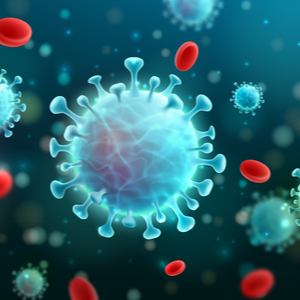
Due to the Corona pandemic, viruses are a big topic - not only the various SARS viruses, of which Corona is one, but the most diverse types. Many people want to know when and for what reasons viruses are dangerous. This is determined by different factors.
Incubation period and symptoms
The incubation period plays an important role in how quickly and how far a disease spreads. The incubation period is the period between infection and the appearance of the first symptoms. However, it is quite possible that people are already contagious during this period. This is why viruses such as SARS-CoV-2 (Corona), which have a very long incubation period, often spread particularly strongly. This is because people have already travelled many distances and had contact with many people before symptoms appear.
Another factor is the intensity of the symptoms. People with flu or pneumonia - which are often accompanied by extreme weakness, high fever and shortness of breath - usually stay home quickly. The situation is different for illnesses that initially, or for most people, are inconspicuous. These include corona, for example, but also HIV and hepatitis. This is why diseases with mild symptoms sometimes spread much further and faster than those with severe symptoms.
Both points apply to viruses as well as bacteria.
Risk of infection and transmission route
The risk of infection depends, among other things, on the number of viruses transmitted. It depends on the specific virus, the route of entry and the immune system of the person affected whether the infection can break out. Unlike many bacteria, viruses are not normally transmitted through water or food. This is due, among other things, to the fact that viruses are much less capable of survival, as they can neither form long-term survival forms nor spores. The only protection they have is a protein coat of varying thickness and the body secretion in which they are encased. That is why they only survive outside the body for a few minutes - like HIV - to a few weeks - like norovirus. Heat and humidity often shorten this span.
The most common modes of transmission are droplets from the respiratory tract, which can fly up to 1.5 metres. However, transmission through air alone is extremely rare. More often, transmission occurs via animals, although the types differ from virus to virus. Some viruses, such as HIV, cannot be transmitted through saliva, but only through semen or the absorption of blood into one's own bloodstream. But surfaces can also be used for transmission, with smooth surfaces being the primary candidates. Transmission through textiles or other rough and absorbent surfaces is also theoretically possible, but only over a short period of time.
Vaccinations and medication
Vaccinations exist against some viruses, such as some strains of hepatitis, some strains of HPV or seasonal influenza. These enable the immune system to recognise the virus and, in the event of contact, to react quickly enough to prevent illness. How long they are effective depends, among other things, on the mutation rate of the virus. For seasonal flu, for example, this is very high, necessitating annual vaccination, which also cannot protect against all strains.
Viruses are not independent life forms like bacteria - they have neither a metabolism nor a diet or their own reproductive structures. This makes them invulnerable to antibiotics, which are used against bacterial infections. Only a few antivirals exist, but they can only have an inhibitory effect on certain viruses. In the case of viral infections, therefore, the focus is on rest and protection as well as treatment of the symptoms.
Conclusion
Viruses are dangerous pathogens that currently play a major role. How they are spread and what the risk factors are vary widely - it is therefore worthwhile to find out exactly how they are spread in order to avoid both panic and infection.
